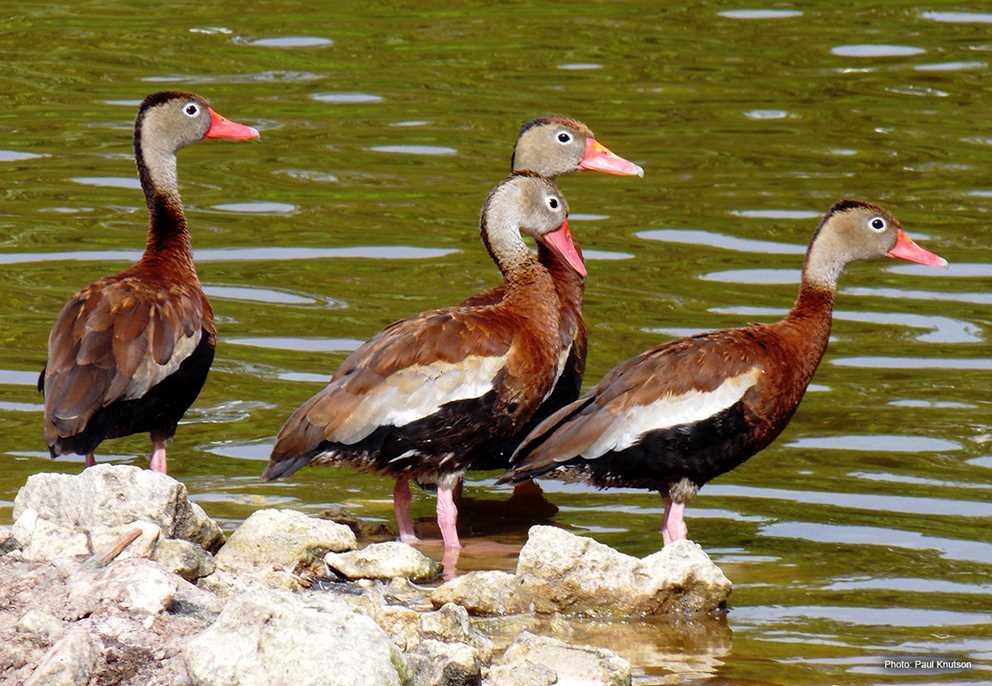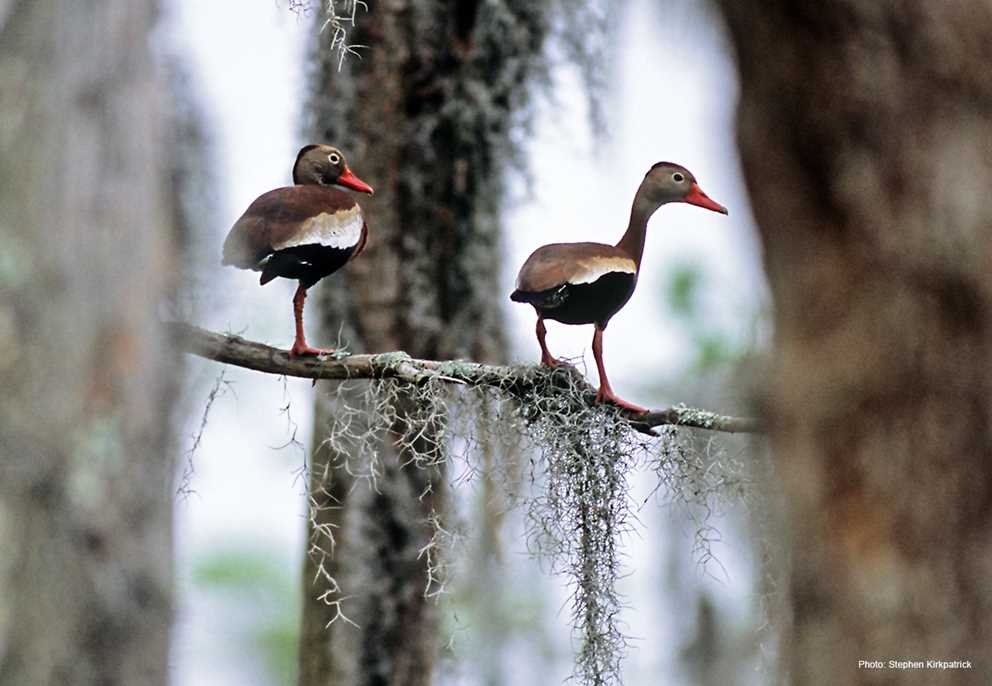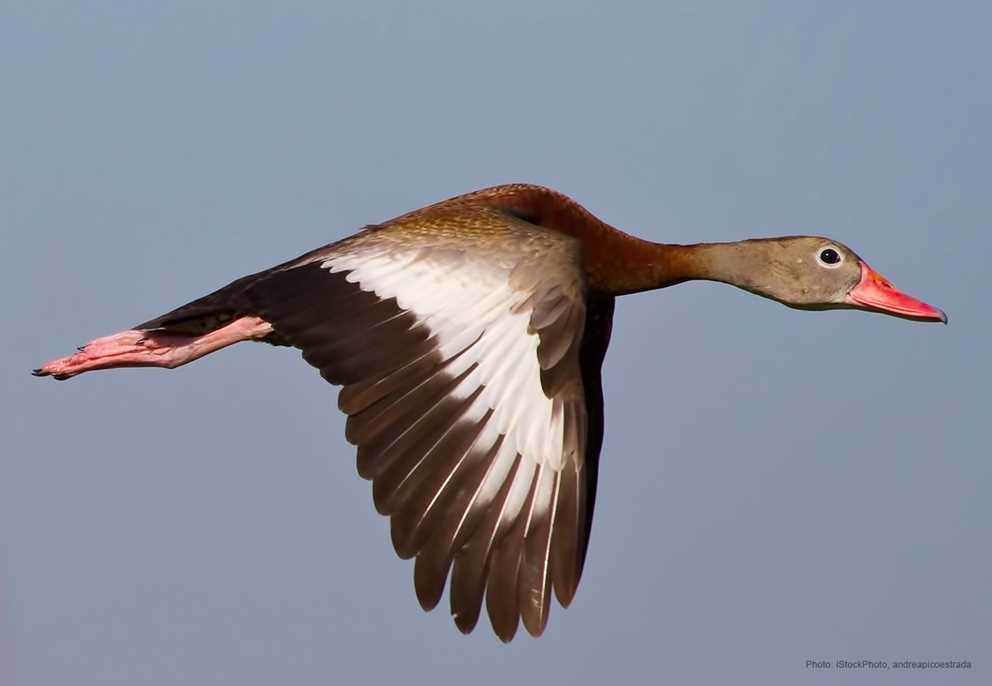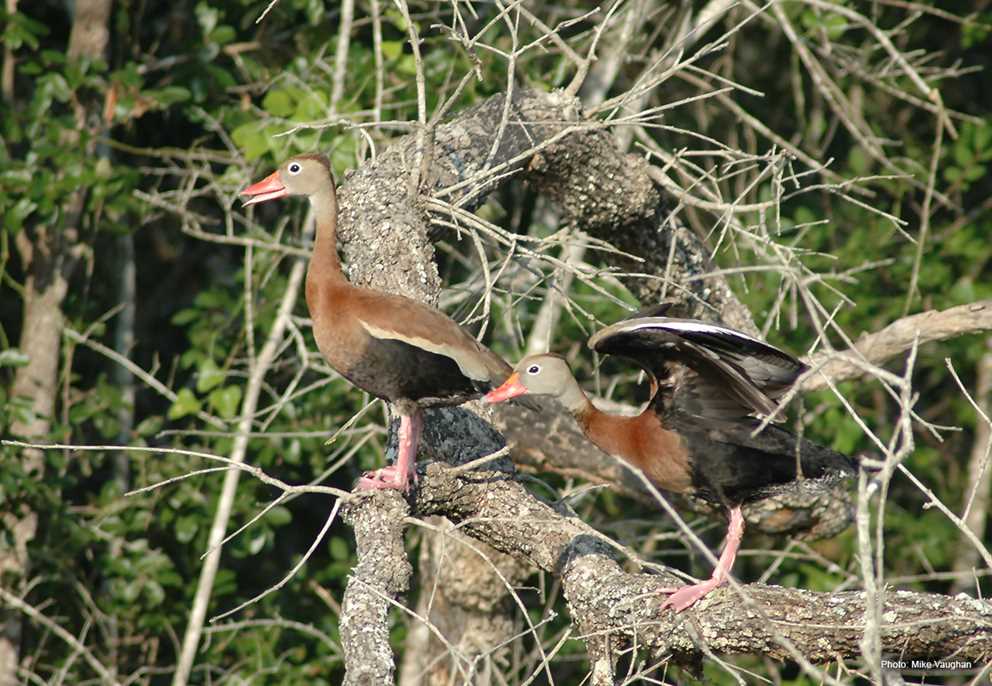Overview
The Black-bellied Whistling Duck is a medium-sized tropical to sub-tropical perching duck. In the United States its range is expanding, extending from southeastern Arizona eastward to coastal South Carolina. In recent years, they have been observed in many Midwestern and East Coast states, and their breeding range is expanding with new records reported regularly. Perched on the ground or in trees, they have an erect posture, pink bills and feet, and a gray face, with a chestnut crown on the head. The neck, back, and breast are a warm chestnut, and belly is black. In flight, the wing has chestnut tertial and secondary coverts that fade to gray then to very notable white that contrasts with black secondary and primary feathers.
Black-bellied Whistling Ducks are cavity nesters and readily use nest boxes, though they will nest on the ground in areas lacking cavities or nest boxes. They are vegetarian, and will make use of agricultural grains, especially rice and corn. The population in the United States is mostly migratory, departing most of their range other than coastal South Texas in winter. Birds residing in tropical and subtropical regions do not migrate.
Description
Key Identification Features
- Wing strokes in flight are slower than most ducks, the feet trail behind the tail, and they typically are very vocal.
- The plumage of both sexes is identical. In flight, a large white patch on the secondary and primary coverts contrasts with the black primaries. At rest, their standing posture is erect.
Male/Female Average Length and Weight
- Mass: Males and females overlap in mass, ranging from1.4–2.3 lbs.
- Wing Length: 8.8–10.3 in.
Male and Female Identification
- Alternate (Breeding) and Basic Plumage: The plumage of both sexes is identical, as are the alternate and basic plumages. The head and face are gray, with a notable white eye ring. The crown is chestnut, and a black streak extends up the back of the neck to the crown. The bill and feet are pink to pinkish orange. The lower neck, breast, and back are chestnut, the belly, flanks, vent, and tail are black. In flight, a large notable white patch on the secondary and primary coverts contrasts with the black primaries.
In-flight Identification
- In flight, a large white patch on the secondary and primary coverts contrasts with the black primaries. Wing strokes in flight are slower than most ducks, the feet trail behind the tail, and they typically are very vocal.
Vocalizations
- Very vocal. A high pitched, soft whistle described as “pe-che-che-ne” with the “pe” longer and drawn out. In flight, may give “chit-chit-chit.” The alarm call is “yip.”
Similar Species
- Adults are unique and unlikely to be confused with any other species of waterfowl in North America. Juveniles resemble juvenile Fulvous Whistling Ducks, but the presence of white wing patch easily separates these two species.
Habitat Preferences
- Black-bellied Whistling Ducks are typically found in freshwater wetlands, ponds, or lakes, usually with emergent or floating vegetation, but sometimes devoid of emergent vegetation.
Foraging Habits and Diet
- Black-bellied Whistling Ducks are vegetarian with a diet often >90% plant material. Vegetation consumed includes seeds of various emergent and aquatic plants. Also feeds on cultivated grains including rice, sorghum, and corn. Invertebrates are usually <10% of the diet but include mussels and various aquatic insects.
Breeding Habits
- Monogamy: They have monogamous, lifelong pair bonds. They are believed to nest at 1 year of age. The breeding season is long, with nest records from April to October in Texas, but peak nesting activity occurs from mid-May to August.
- Nest Locations: Most nests are in natural cavities or nest boxes, with eggs laid directly in cavity debris or wood chips in boxes, and neither sex deposits down in the nest as incubation proceeds.
- Clutch Size: The average clutch size in Texas was 13.4 eggs, with much larger clutches resulting from dump nesting or intraspecific nest parasitism. The eggs are white to creamy white, elliptical to oval and average 2.0 by 1.5 in. The incubation period is about 28 days, with males and females alternating incubation of the eggs.
Migration & Distribution
- Fall Migration: Black-bellied Whistling Ducks usually depart breeding areas between August and October.
- Spring Migration: They overwinter in Central and South America and return to breeding areas in late March or April.

Conservation Status
- IUCN Status: Least Concern
- Population Status: The global population is roughly estimated at 1–2 million birds. Black-bellied Whistling Duck numbers appear to be stable to increasing throughout their range, but the species is not subject to large-scale surveys. Christmas Bird Count data suggest an increasing population trend with sightings of 1,822 per year in the 1980s, to 12,227 per year in the early 2000s. They appear to be undergoing a substantial range expansion in the southeastern United States, and increasingly, post-breeding birds are being observed in Midwestern states as well. Breeding Bird Survey data in the United States suggests populations are increasing, perhaps by as much as 8% annually. In some areas, lack of natural cavities may be limiting, and nest boxes may help to increase populations locally.
- Conservation Concerns: The primary threat is habitat loss.
- Conservation Focus: Conservation efforts focus on protecting habitat, constructing nest boxes, and population monitoring.
Harvest Information
- Harvest is believed to be very low, estimated to be below 20,000 annually, with the most harvest occurring in Texas and Louisiana. Harvest is low in part because Black-bellied Whistling Ducks depart their breeding areas before most waterfowl hunting seasons open.




